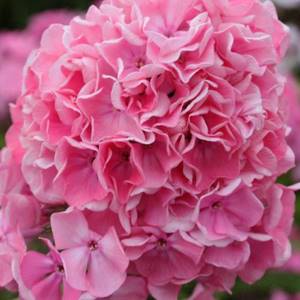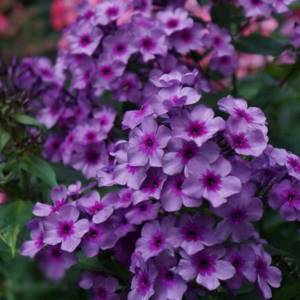Phlox, which means “flame” in Greek, is a spectacular herbaceous flower that includes up to 85 species. Another name is awl-shaped phlox. The resemblance of the leaves and stems to the awl is obvious. Widely distributed in North America. One species is found in the wild nature of Russia - Phlox Siberian. The stems reach a height of up to 1.5 meters, the flowers are small and fragrant, reminiscent of an enlarged branch of lilac. There can be up to 90 of them in an inflorescence. Colors for every taste: from soft white, white with specks to lilac, scarlet, purple. Resistant to cold and drought.
Brief overview of the article
Types of perennial phlox
- Early varieties of phlox: Amadeus, Alexandrite, Benefis, Zephyr, Heaven, Mishenka, Hello, Sakura blossoms.
- Late varieties: Bely Late, Hans Wollmoller, Graf Zeppelin, Vladimir Lebedushka, Cool Water, Moskvichka, Margarita, Magic Blue, Flammkuppel, Chocolate, Hesperis.
- One of the latest is Orange Perfection and Baby Face. Varieties of early and late phlox with photos and names below.
Attention! If you want a riot of colors all summer, combine early and late varieties of flowers on your site.
Transfer
The plant should be replanted every 3-6 years. There are several reasons for this:
- rejuvenation of the plant (otherwise, over time, the flowers are crushed);
- poor soil (depletion is inevitable even with frequent fertilization);
- diseases, pests.

Spring transplantation is carried out at the end of April and until mid-May. Late varieties are grown from mid-September to October. There is no point in delaying the autumn transplant. Perennial phlox flowers need time to get used to a new place before frost.

The depth of the hole is 30 cm. The distance between plants is about half a meter, but you need to keep in mind the size of the phlox. For example, the Baby Face variety is a border variety and the distance between the seeds can be reduced.

Transplant principle
They dig up the stem and leaves along with a lump of earth, cutting the overgrown bush with a shovel. Shoots formed at the base must be placed below ground level. Plant a bush, cover it with soil, water it, add fertilizer and sprinkle the bush again (so that there is no crust).
Landing
To plant paniculate phlox, you need to prepare a hole. It should not be made too deep; it is necessary that the root system measuring 18-20 cm fits freely. It is better to make the hole wider as the bush grows. 50-70 cm is enough, and after a few years the phlox will not leave any free space.
It can be planted in the fall at the end of the gardening season or in early spring. If planting occurs in the spring months, then it is necessary to add mineral and organic fertilizers to the hole. Seedlings should be placed in the hole carefully so as not to harm the roots. This is best done by transferring the earthen clod along with the root system.
Reproduction
Phlox can take root in different ways. There are five main ways to plant phlox:
- Stem cuttings. An easy way for beginners. Usually carried out before flowering. The shoots are chosen to be healthy. You need to cut the shoot into cuttings so that 2 nodes remain. There should be 2 cm from the top of the knot (from the cut). The leaves are removed from below, and the leaves from above are cut in half. Cuttings are planted in a plot or as seedlings.
- Leaf cuttings. In early July, a leaf with a bud and a thin layer of stem is cut and planted in a planting box or open ground with light soil. Pour 1 cm of vermiculite. The cuttings are planted to a depth of 2 cm so that the bud and stem are completely in the soil and the leaf is on top. Cover with glass, the leaf takes root for a month, and is sprayed from time to time.
- Divide the bush in early spring or autumn. In summer it is possible in emergency cases and in cloudy weather. They are usually planted with a clod of earth or by shaking off and washing the roots. This option is similar to a transplant.
- Propagation by root cuttings in late autumn or spring. This method is labor intensive. For it you need to select large fleshy roots, divide them into parts 5-6 cm thick. Plant them in a box with soil, sprinkle with sand 4 cm deep. If work is carried out in the fall, the cuttings are removed to a room with a temperature of 2-3 ° C. In spring, the boxes are closed from light for 2 weeks, increasing the temperature from 10 to 25 oC. In both cases, the temperature is raised gradually and carefully accustomed to light.
- Reproduction by layering. A simple method is to place the bush in the ground, covering it high with soil. Roots gradually form on it. After this, the bush is shaken off the ground, trimmed and planted in the soil.
Annual phlox
The Drummond variety is the only representative of annual phlox. All other varieties are its varieties. They are conventionally divided into two groups: star-shaped and large-flowered.
Planting annual phlox
Annual phloxes are grown mainly in greenhouses and on window sills. Flower growers, fearing spring frosts, do not risk sowing seeds directly into open soil. They germinate young plants in warm conditions, and then plant the seedlings in the front garden.
Flowers are sown in the second half of March. The first shoots appear within one and a half to two weeks. Now they need to provide warmth, humidity and good light, and dive after 20-23 days. Immediately after diving, the plants are protected from direct sunlight, for example, covered with newspaper.
Already in May, the day before young phlox are planted in the soil, they are fed with mineral fertilizers.
Sandy soils are the most suitable for annual phlox.
Caring for annual phlox
Growing annual phlox is a pleasant and easy process. All care consists of:
- regular loosening of the soil, 6 to 8 times per summer;
- hilling with each loosening;
- feeding with mineral supplements (4 times per season);
- moderate regular watering.
If you follow these simple rules, phlox will grow actively and delight you with its flowers throughout the whole summer and half of autumn.

Top dressing
Minerals, ash, humus, compost or manure are the best additives that will make the bushes powerful and healthy. Usually fertilize up to 5 times a year. This:
- early spring;
- mid-May (nitrogen-containing fertilizing);
- mid-June (potassium sulfate or ash);
- July (we add phosphates to the fertilizing)
- August (for late varieties based on phosphorus and potassium).

How to grow Phlox paniculata
08/12/2013 12:00 Share: PHOTO: www.shutterstock.com The second name - “sitchik” - was given to phlox, probably because their coloring resembles the bright colors of light summer fabric.
Take advantage of this advantage of plants by making a variegated flower garden on your site. Multi-colored phlox
Phlox bloom profusely, forming a real “torch show” with an amazing aroma. The color of the flowers is multicolored: from pure white to carmine, lilac, pink, blue, crimson with various borders, eyes, spots and strokes.
The shapes of inflorescences can be cone-shaped, spherical, pyramidal, or umbrella-shaped. One inflorescence can have from 20 to 100 flowers. Phlox blooms from June to October.
Where to plant
One of the main requirements when growing paniculate phlox is abundant watering .
Even in places with close groundwater, during periods of prolonged drought, these plants suffer greatly from drying out.
The second important condition is high soil fertility.
It is best to plant phlox in a sunny area , but they should be shaded during the hottest time of the day .
In partial shade, these flowers also grow well, but they stretch out a little, bloom later and their color becomes somewhat paler.
In open, sunny places, phlox grow strong, stocky, and brightly colored, although dark varieties may fade slightly.
How to prepare the soil
Phloxes are very resilient and hardy. However, for abundant and long-lasting flowering of these plants, it is worth paying attention to site preparation. The soil should be nutritious, well-fertilized, loose, moist, sandy loam or loamy, slightly acidic or close to neutral (pH from 5.5 to 7.0).
The best effect on the development and flowering of phlox is the application of decomposed horse or cow manure, composts, leaf humus, ash in combination with mineral fertilizers and organomineral mixtures.
The root system of paniculate phlox is powerful and penetrates to a depth of 25–30 cm, so the depth of the prepared soil layer should be no less than a spade bayonet. On heavy clay soils, coarse river sand, compost, lowland peat and well-rotted manure are added. Sandy loam soils need to be made more moisture-absorbing and nutritious. For this purpose, clay, turf soil, compost or manure are added.
As nutrients, use any complex mineral fertilizers containing sodium, potassium and phosphorus, or a mixture of ammonium nitrate (25 g/m2), double superphosphate (35–50 g/m2) and potassium sulfate (15 g/m2).
When applying organic fertilizers along with minerals, the doses of the latter should be reduced. It is important to remember that increasing doses of fertilizers higher than recommended leads to inhibition and even death of plants.
Correct fit
Phloxes are best purchased from well-known nurseries and farms, as well as from professional amateurs.
A standard planting unit in autumn should have 2-3 thick stems, large renewal buds at their base and a strong, healthy root system, shortened to 10-15 cm.
In garden centers, phlox is sold in containers or colorful bags in peat, sawdust or other substrate. The best planting material is plants obtained from cuttings of the second year of cultivation.
Planting phlox is not much different from planting traditional perennials. The roots are placed freely in the dug hole, straightening them so that they are directed in different directions and slightly downward. It is recommended to powder them with Kornevin, cover them with soil and gently press them with your hands. Renewal buds are buried 4–5 cm.
Low-growing and border varieties are planted at a distance of 35–40 cm. 6–7 plants can be planted per 1 m2. Medium-sized varieties with a height of 70–90 cm are placed at a distance of 50–55 cm from each other. For tall varieties with a height of 100–150 cm, the distance should be 60–70 cm from each other.
Boarding time
Phloxes are planted in spring, summer and autumn. Each planting period has its positive and negative sides and depends on many circumstances.
The best time for spring planting is the second half of April, for autumn planting - the second half of September - early October. Plants should be well rooted before frost sets in. When planted in autumn, phlox develop more actively the following spring and bloom on time in the summer.
In autumn they are planted with leaves, cutting off only the upper part of the stem. When planted in spring, phloxes take root well, but their flowering is delayed by 10–15 days. The planted plants must be watered abundantly and then watered every 3-4 days for two weeks.
Summer planting of flowering plants allows you to be absolutely sure of the variety of plants. After planting, it is necessary to cut out the inflorescences, shade the plants and, in case of hot and dry weather, water and spray them in the morning and evening.
For better survival rate when planting and replanting in the summer, it is advisable to use the preparations “Epin”, “Kornevin”, focusing on the instructions for their use.
Secrets of care
Weeding, watering, loosening and fertilizing are the main stages of phlox care.
To get lush flowering, it is necessary to properly feed the plants, and this is due to the phases of their development.
In the first phase (in the spring during the period of intensive growth of stems and leaves), nitrogen and water are mainly added.
In the second phase (budding and flowering), the need for nitrogen decreases, but the need for potassium and phosphorus increases.
In the third phase (ripening of seeds, accumulation of nutrients in rhizomes and roots), plants intensively absorb phosphorus and prepare for winter.
During the spring-summer period, three feedings are carried out. The first - in early spring after the snow melts with any complex mineral fertilizer (for example, Kemira) - 50 g/m2.
The second feeding is carried out at the beginning of budding, and the third after flowering with the same fertilizers as the first. Fertilizing should be done after rain or heavy watering, in the evening. Foliar feeding of phlox with microelements is very useful. To do this, it is better to use ready-made preparations “Uniflor micro” or “Cytovit”. In the absence of the proposed drugs, you can use an infusion of ash.
Phlox are moisture-loving plants; watering should be plentiful so that water penetrates to the roots. At the end of October, the stems should be cut off close to the ground and burned. To protect plants from freezing, they are mulched with peat or compost with a layer of 5–10 cm.
Easy propagation
Phlox paniculata can be called champions in the number of methods of reproduction. Almost any part of them can form a new, young independent plant.
most common method is dividing the rhizomes . Plants are divided when they have grown well. You just need to dig up the phlox, shake it off the ground a little and divide the rhizome into pieces with your hands, a knife or a shovel.
If there is a need for a small section, it is not necessary to dig up the entire bush. It is enough to cut and separate a small part of the plant with a shovel, and add nutritious soil to the resulting hole.
Phlox can also be propagated quite easily by cuttings , which are taken from various parts: spring growth shoots, stem pieces, axillary side shoots, leaf cuttings and root cuttings (thick pieces of roots).
superdom.ua
Bloom
The flowering period is from mid-June to the end of September. Its peak begins in mid to late July. Late varieties begin to delight from August until late autumn. Phlox can rebloom if the inflorescences are trimmed.
Pests and their control
If the phlox is thin, with an excess of stems that have little or no flowers, the plant has been affected by the growth virus. Phlox cannot be divided or replanted. It should be dug up and thrown away in a lump.
- Powdery mildew is the most common disease. White spherical spots gradually cover the leaves and, in advanced cases, curl them. Spraying in early June with a solution of iodine or soda prevents the appearance of the pest. You can use branded drugs “Topaz”, “Skor”.
- The activity of nematodes and pennies must also be stopped. Usually these are the drugs “Confidor”, “Aktara”.
- Wireworms, caterpillars and earwigs are the least dangerous pests for the plant.

Attention! Weeding, loosening and watering with pest repellents are good preventive measures.

This is interesting. If you plant peas, chicory, mustard, marigolds, dill, and parsley nearby, nematode activity can be minimized.

Many gardeners believe that phlox is a flower with no problems to grow. Flowers are not a hassle to care for, but the basic principles of growing are worth knowing. And if you combine early and late flowering varieties, you can create a piece of paradise with colorful islands of flowers and a delicate aroma all summer long.
Diseases and pests
The phlox flower garden may suffer from powdery mildew. Nematodes are dangerous for the plant and completely destroy the flower. One of the unwanted diseases is variegation, a virus that can destroy entire collections of bushes in a day. In addition, an infected plant is a source of disease. Insects transmit the virus to healthy plants that they pollinate. Garden phlox can also suffer from a rare disease called jaundice, the causative agent is mycoplasma. Carried by flies and cicadas. To prevent pests and various viruses and diseases, you should spray the bush with Zineb or Fundazol; before use, you must read the descriptions of the drugs.
Phlox paniculata is a beautiful plant that is unpretentious in care, and thanks to its bright varieties, you can create truly bright color compositions.











